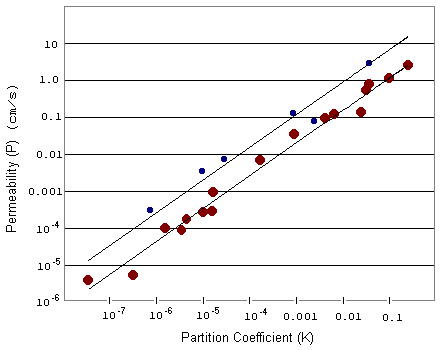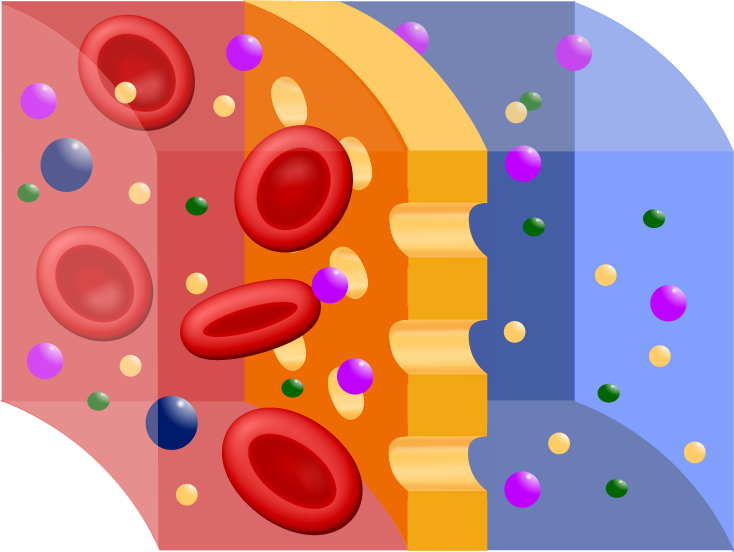博文
Membrane permeability
||
In the late 1800's, E. Overton discovered that substances that dissolve in lipids pass more easily into the cell than those that dissolve in water. This was some of the first evidence that cells were surrounded by a lipid membrane. The phospholipid membrane of cells can greatly modify the permeation of molecules into a cell. The membrane acts as a barrier to passive diffusion of water-soluble molecules. However, substances that dissolve in lipids pass more easily into the cell. The correlation between permeability and solubility in lipidly is appropriately named Overton's Rule.
The rate of diffusion into a cell (see DIFFUSION THROUGH THE CELL MEMBRANE) is related to the substrate's concentration, as well as properties of the substrate that determine its permeability. We can use an equation relating permeability to properties of the diffusing molecule to see how well permeability correlates with the dissolvability of molecules in nature.
Membrane permeability is a quality of a cell’s plasma membrane that allows substances to pass in and out of it, so that the cell can expel waste products and ship out the chemicals it assembles for the body. At the same time, the nutrients that the cell needs can pass through the membrane to the inside. Cell membranes have selective permeability, meaning that they will allow certain substances to pass while forming a barrier against others.
Cells are like microscopic factories: they design, produce, and package the substances the body needs to survive each day. Just like a factory, a cell needs a way to bring the raw materials for its products — such as nutrients from food — inside its workshop. Once it has assembled and packaged a substance, the cell needs a way to ship the finished product out into the bloodstream so that the body can make use of it.
The membrane is a flexible plasma that envelopes the exterior boundaries of the cell. It separates the intracellular fluid — the fluid within the cells — from the extracellular fluid, found outside of the cells. The membrane is not a passive or insurmountable wall, however, as there is a constant and dynamic exchange of substances between the two fluids.
Small molecule permeability through cellular membranes is critical to a better understanding of phar- macodynamics and the drug discovery endeavor. Such permeability may be estimated as a function of the free energy change of barrier crossing by invoking the barrier domain model, which posits that permeation is limited by passage through a single ‘‘barrier domain’’ and assumes diffusivity differences among compounds of similar structure are negligible.
Permeability (P) of molecules across a membrane can be expressed as
$P=\tfrac{KD}{\Delta X}$
P: permeability coefficient for a particular substrate (cm/sec)
K: partition coefficient
D: diffusion coefficient (cm2/sec)
Dx: width of the cell membrane (cm)

where K is the partition coefficient, D is the diffusion coefficient, and Dx is the thickness of the cell membrane. The diffusion coefficient (D) is a measure of the rate of entry into the cytoplasm depending on the molecular weight or size of a molecule. K is a measure of the solubility of the substance in lipids. A low value of K describes a molecule like water that is not soluble in lipid.
Graphically, we expect permeability (P) as a function of the partition coefficient (K) to increase linearly when D and Dx are constants. If we collect data for a variety of substances, we can plot permeability against partition coefficients to see how well the data fit our equation. Since the values are very small (ranging from 0.000005 to 4.0), we plot the x and y axes on log scales.

Interpretation: By plotting the data, we see that P does linearly increase with K, as described in our original equation. The small blue circles describe smaller molecules while the large red circles describe larger molecules. For a particular partition coefficient, the permeability of a smaller molecule is generally higher than that of a larger molecule.
Let's look again at the equation for permeability. When we plot P as a function of K, the slope of this line is given by D/Dx. Since smaller molecules generally penetrate more easily through the cell membrane, the diffusivity (D) is higher for smaller molecules. Thus when we plot P as a function of K for small and large molecules, we expect the line for the smaller molecules to have a larger, or steeper, slope. This is more easily seen when we plot the above data on a regular scale.
Indeed we find that the line for the smaller molecules has a much steeper slope attributed to the greater diffusion coefficient of smaller molecules.
The permeability of molecules through a cell membrane can be well described as a linear function of the partition coefficient with slope dependent on molecule size. For molecules of equal size, the one with greater solubility in lipids will pass more quickly into the cell. For molecules of equal solubility, smaller ones penetrate faster.
A semipermeable membrane, also termed a selectively permeable membrane, a partially permeable membrane or a differentially permeable membrane, is a membrane that will allow certain molecules or ions to pass through it by diffusion and occasionally specialized "facilitated diffusion".
The rate of passage depends on the pressure, concentration, and temperature of the molecules or solutes on either side, as well as the permeability of the membrane to each solute. Depending on the membrane and the solute, permeability may depend on solute size, solubility, properties, or chemistry. How the membrane is constructed to be selective in its permeability will determine the rate and the permeability. Many natural and synthetic materials thicker than a membrane are also semipermeable. One example of this is the thin film on the inside of an egg.

Scheme of semipermeable membrane during hemodialysis, where blood is red, dialysing fluid is blue, and the membrane is yellow.
An example of a semi-permeable membrane is the lipid bilayer, on which is based the plasma membrane that surrounds all biological cells. A group of phospholipids (consisting of a phosphate head and two fatty acid tails) arranged into a double-layer, the phospholipid bilayer is a semipermeable membrane that is very specific in its permeability. The hydrophilic phosphate heads are in the outside layer and exposed to the water content outside and within the cell. The hydrophobic tails are the layer hidden in the inside of the membrane. The phospholipid bilayer is the most permeable to small, uncharged solutes. Protein channels float through the phospholipids, and, collectively, this model is known as the fluid mosaic model.
In the process of reverse osmosis, thin film composite membranes (TFC or TFM) are used. These are semipermeable membranes manufactured principally for use in water purification or desalination systems. They also have use in chemical applications such as batteries and fuel cells. In essence, a TFC material is a molecular sieve constructed in the form of a film from two or more layered materials.
Membranes used in reverse osmosis are, in general, made out of polyimide, chosen primarily for its permeability to water and relative impermeability to various dissolved impurities including salt ions and other small molecules that cannot be filtered. Another example of a semipermeable membrane is dialysis tubing.
Other types are cation exchange membrane (CEM), charge mosaic membrane (CMM), bipolar membrane (BPM), anion exchange membrane (AEM)[1]alkali anion exchange membrane (AAEM) and proton exchange membrane (PEM).
The diffusion of water through a selectively permeable membrane is called osmosis.
Reference:
http://en.wikipedia.org/wiki/Semipermeable_membrane
JACS 2006,128(43)14073-14080
JCAMD 2007,21(12)675-679
https://blog.sciencenet.cn/blog-355217-692895.html
上一篇:Class F G-protein-coupled receptor released
下一篇:could it flip?